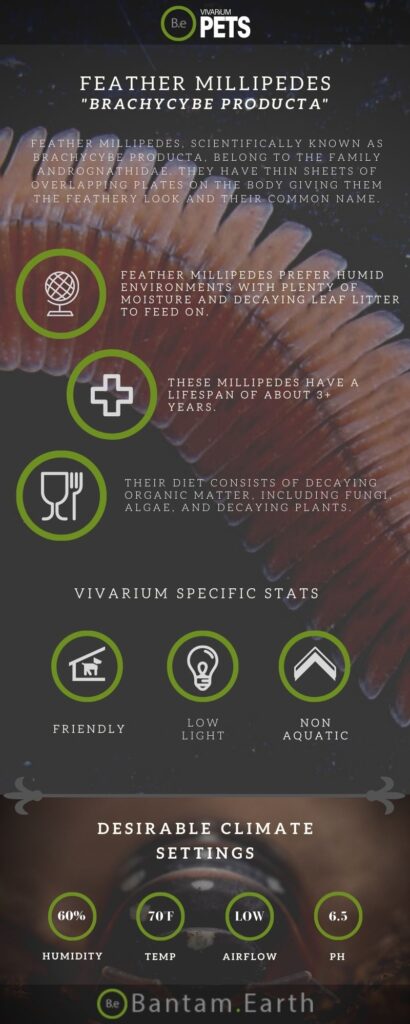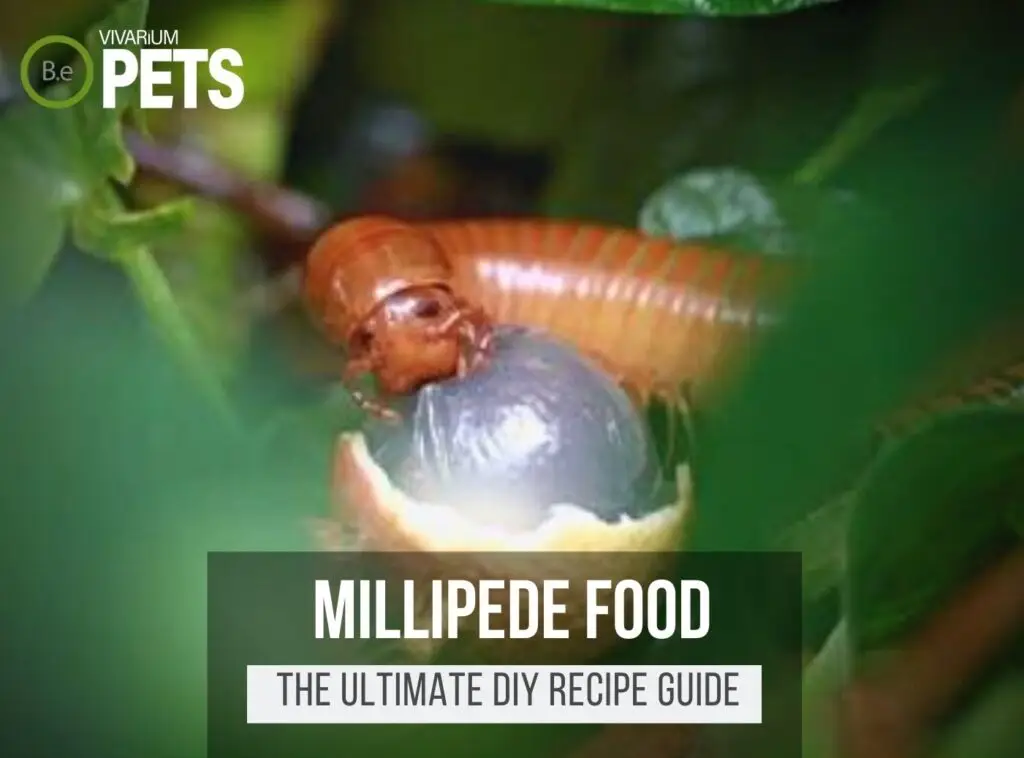I think my next stranger things vivarium will absolutely have Feather Millipedes (Brachycybe producta) as a resident!
The Brachycybe producta is a fascinating arthropod that is native to North America.
They are small millipedes and easy to care for and make great pets if the appropriate environment is provided.
With the correct setup, understanding of their diet and temperature needs, as well as proper handling, these potential pet millipedes can live long, healthy lives.
Read on to find out more about this amazing species!
| Characteristics: | |
|---|---|
| Common Name | Feather Millipede |
| Family Name | Andrognathidae |
| Scientific Name | Brachycybe producta |
| Use | Cleaning, Aerating Soil, Pets |
| Temperament | Non-aggressive |
| Lifespan | 3+ Years |
| Diet | Detritivore |
| Adult Size | 2.54 cm |
| Breeding Type | Egg Layer |
| Care Level | Easy |
| Minimum Tank Size | 10-15 Gallons |
| pH | 6.0-7.0 |
| Hardness | Moderate |
| Temperature | 60-75°F |
What Are Feather Millipedes?
Feather Millipedes, scientifically known as Brachycybe producta, belong to the family Andrognathidae.
They have thin sheets of overlapping plates on the body giving them the feathery look and their common name.
Feather Millipedes are entirely harmless and make for great vivarium pets, due to their small size, unique appearance, and docile nature.
What Do Feather Millipedes Look Like?
Brachycybe producta are small millipedes, measuring only around 2.5 cm in length.
They are narrow and slender, with an almost cylindrical body. Their heads are typically smaller than the rest of their body.
They have a hard exoskeleton, which is typically tannish-brown in color, and a very distinctive pattern of white sections on the body that resemble feathers.
These sections can be more “streaky” or linear depending on the species, but the general pattern is the same.
They have a set of legs at each segment of their bodies, ranging from 16 to 19 pairs in total.
The number of legs is species-dependent and can be used to tell them apart.
Benefits Of Using Feather Millipedes
Using Feather Millipedes in vivariums is a popular choice for many reptile keepers and critter enthusiasts alike.
Their small size makes them easy to care for and their unique aesthetic makes them an eye-catching addition to a terrarium.
They also serve an essential role in helping to keep the enclosure clean by eating leftover food and decomposing organic material.
This helps maintain the overall health of the tank and, ultimately, its inhabitants.
For those who are looking for an interesting and low-maintenance pet, the Brachycybe producta is an excellent choice.


Feather Millipede Facts
Feather Millipedes are small, hardy arthropods native to North America.
They prefer a diet of leaf litter and decaying plant matter, and while they can be skittish, they also require gentle handling to avoid stress.
With proper care, these insect pets can live up to three years and can be bred in captivity with ease.
Habitat
Brachycybe producta can be found throughout various regions of North America.
The species was discovered living in higher altitude vegetation that is mainly composed of low shrubs, grasses, and mosses.
Feather Millipedes prefer humid environments with plenty of moisture and decaying leaf litter to feed on.
They are nocturnal, and so they are often seen at night.
During the day they prefer to hide in moist, dark places, like bark crevices, low shrubbery, or wood piles.
Diet
In their natural habitat, Feather Millipedes mainly feed on decaying organic matter such as leaves and other vegetation.
They spend much of their time digging beneath the surface of the soil searching for food sources.
While they also consume edible fungi, fruits, and other insects, their primary food source is leaves that have begun to decompose.
Their diet mainly consists of non-living vegetation, which they can move and chew while they feed on it.
They can absorb all the nutrients from the decaying plant matter that they feed on and process it in the same way as other millipedes.
With a combination of breakdown and absorption, the small pieces are then fermented and passed through their intestine, to be broken down and digested further.
When searching for food sources in the wild, Feather Millipedes move in a slow, amble motion, as they dig and chew their way through the soil and decaying vegetation in search of nutrients.
They are even able to climb up rocks, trees, and branches to reach their food sources.
Temperament
Brachycybe producta are known to be among some of the most docile invertebrates.
Generally, they are intimidated rather than aggressive when they come into contact with humans.
When they feel threatened, they will generally curl or roll up, making it easy to grab or handle.
In terms of other animals, these millipedes will generally get along with other invertebrates.
When in contact with larger or more aggressive animals, Feather Millipedes may be seen running away or creating a defensive shield around themselves.
Lifespan
The Feather Millipedes have a fairly long lifespan for an invertebrate. With proper care and careful handling, these millipedes live for up to three years.
Further, if food and water are regularly supplied, the duration of their life can be extended.
During their lifespan, Brachycybe producta will go through several stages of growth, or instars, as they grow and molt before reaching maturity.
The life cycle includes the egg, nymph, and adult stages, when they reach adulthood they are fully grown and can reproduce.
Molting is a crucial part of their life cycle and it takes a significant amount of energy, which is why food and water must be regularly supplied to your Feather Millipedes.
Breeding
Brachycybe producta mate and reproduce similarly to other millipedes.
To find a mate, males of the species will move around in search of a female, guided by pheromones.
When a male finds a suitable female, he will attach himself to her back and remain there for several hours to ensure that she successfully receives his sperm.
When the female is ready to lay her eggs, she will roll up into a ball, burying her eggs inside her body.
This unusual method of egg-laying is a way in which the species preserves egg survival against harsh temperatures and potential predators.
After being buried, the eggs will hatch in 2-3 weeks.
During this stage, the young are provided with nutrition and protection until they can forage for themselves.
At this stage, they will grow rapidly and shed their exoskeleton several times until they reach adulthood.
Where To Find Feather Millipedes
Feather Millipedes are not typically found in captivity and wild-caught specimens are harder to obtain.
The best way to find a captive-bred millipede is to contact a local reptile store or research reputable online retailers who specialize in the sale of captive-bred arthropods.
When looking for captive-bred Brachycybe producta for sale, it is important to ensure that you are purchasing healthy specimens.
If possible, take a look at the millipede to make sure they are active and healthy looking.
Feather Millipede Care
To care for Feather Millipedes, you’ll need to provide the right temperature, humidity, and substrate in their enclosure.
They need a nutritious diet of fruits and vegetables, as well as other treats.
Proper care and handling will help your pet live a long, healthy life.
Tank Requirements
A Feather Millipede’s ideal tank is 10 gallons or less, however, they do not need a large tank size because they are quite small.
It is important to create the right environment for your pet by providing a secure and comfortable enclosure.
The vivarium type will depend on the level of humidity your species requires, but a tropical terrarium with good ventilation works best.
The ideal pH for the tank is 6.5-8.0 with a hardness of about 3.0-10.0dkH.
When it comes to temperature, you should keep the tank between 70-80F to provide the most comfortable temperature for your pet.
A terrarium soil that resembles their natural habitat will include tiny pieces of bark and peat moss.
Lastly, Feather Millipedes can live both in complete darkness and with low light. Terrarium lighting should be timed to mimic day/night cycles.
What Do Feather Millipedes Eat?
Feather Millipedes are omnivorous creatures, meaning that they consume both proteins and vegetables to live a healthy life.
Here are some of the food sources they enjoy:
- Fruit (Apple, Banana, etc)
- Vegetables (Carrots, Peppers, etc)
- Leafy Greens (Spinach, Kale, etc)
- Grains (Brown Rice, Oats, etc)
- Decaying Food (Fruit Flies, Crickets, Earthworms, etc)
It’s important to provide a variety of food sources and rotate them to keep your pet nourished and healthy.
Cut up these foods into small pieces and place them on the substrate of your pet’s terrarium.
You can also place food in dishes or feeders at night when your millipede is most active.
To ensure your pet remains hydrated, mist the enclosure every once in a while or provide a shallow water dish that can be easily accessed.
Be sure to remove any uneaten food the following morning, as this will help maintain a clean environment.
If you’re more of an avid hobbyist like myself, be sure to check out my ultimate DIY Millipede food guide. I give a more in-depth explanation of the best foods and my favorite recipe.
Best Tankmates For Feather Millipedes
When searching for the best tankmates for your Feather Millipedes, it is important to choose animals that have similar needs and will not cause any harm to the millipedes.
Some great companion animals for Brachycybe producta include pet isopods, springtails, and earthworms.
All of these animals can thrive in a similar humid environment with a well-shaded substrate and will not cause any harm to the millipedes.
They can also help keep the tank clean by breaking down any debris and eating leftover food.
These tankmates are also undemanding and can tolerate lower temperatures, and will help keep the soil aerated.
Conclusion
This Brachycybe producta Care guide has given you an insight into the basics of keeping this unique species of pet millipedes. With the right environment and proper feeding and handling, your pet can thrive in captivity.
To make sure your pet has a long and healthy life, make sure to monitor their health, provide them with suitable temperatures, humidity, and substrate, and feed them according to their dietary needs.
With the right approach and care, you can keep a happy and healthy Feather Millipede for years to come.
Frequently Asked Questions
Adult Brachycybe producta millipedes typically grow to be around 2.5 cm (1 inch) in length and have a flat, elongated body. They have numerous pairs of legs, with each segment of their body bearing two pairs of legs. These millipedes are typically brown or reddish-brown in color and have distinctive feather-like bristles on their legs.
Feather millipedes, like many other millipedes, are detritivores, which means they feed on decomposing organic matter such as dead plant material and leaf litter. In their natural habitat, feather millipedes can be found in forests, woodlands, and other areas with high levels of leaf litter and decaying organic matter.

